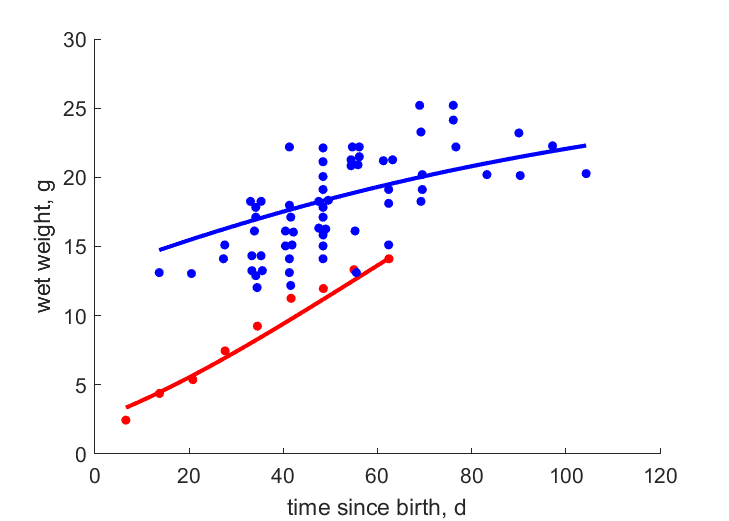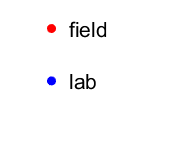Predictions & Data for this entry
| Model: stx | climate: Cfb, Dfb, Dfc | migrate: | phylum: |
| COMPLETE = 2.5 | ecozone: THp | food: bxM, xiHl, xiHs, xiCi, xiF | class: |
| MRE = 0.070 | habitat: 0iTh, 0iTf, 0iTg | gender: Dg | order: |
| SMSE = 0.011 | embryo: Tv | reprod: O | family: |
Zero-variate data
| Data | Observed | Predicted | (RE) | Unit | Description | Reference |
|---|---|---|---|---|---|---|
| tg | 24 | 24.13 | (0.00538) | d | gestation time | Wiki |
| tx | 17 | 19.95 | (0.1736) | d | time since birth at weaning - lab | GerlBart2001 |
| tp | 71 | 63.32 | (0.1082) | d | female sexual maturity | geno |
| tpm | 65 | 64.77 | (0.003501) | d | male sexual maturity | geno |
| am | 2300 | 2288 | (0.005129) | d | life span | geno |
| Li | 11 | 10.97 | (0.00317) | cm | ultimate length (head + torso) - field 3 | kleins |
| Ri | 0.1642 | 0.1597 | (0.02718) | #/d | maximum reprod rate | GerlBart2001 |
| Wwb | 2.5 | 2.729 | (0.09161) | g | wet weight at birth - animal div | ADW |
| Wwx | 8 | 6.208 | (0.224) | g | wet weight at weaning wild | poster |
| Wwp | 14 | 15.8 | (0.1288) | g | wet weight at puberty female | ADW |
| Wwpm | 25 | 25.1 | (0.004082) | g | wet weight at puberty male | ADW |
| Wwi | 44 | 44.88 | (0.0201) | g | ultimate wet weight | kleins |
Uni- and bivariate data
| Data | Figure | Independent variable | Dependent variable | (RE) | Reference |
|---|---|---|---|---|---|
| tW1 |   | time since birth | wet weight | (0.0546) | Flow1972 |
| tW2 |   | time since birth | wet weight | (0.1286) | Flow1972 |
Pseudo-data at Tref = 20°C
| Data | Generalised animal | Apodemus sylvaticus | Unit | Description |
|---|---|---|---|---|
| v | 0.02 | 0.02669 | cm/d | energy conductance |
| p_M | 18 | 169.9 | J/d.cm^3 | vol-spec som maint |
| k_J | 0.002 | 0.002 | 1/d | maturity maint rate coefficient |
| k | 0.3 | 0.0923 | - | maintenance ratio |
| kap | 0.8 | 0.5646 | - | allocation fraction to soma |
| kap_G | 0.8 | 0.8004 | - | growth efficiency |
| kap_R | 0.95 | 0.95 | - | reproduction efficiency |
Discussion
- Males are assumed todiffer from females differ by {p_Am} and E_Hp only
Facts
- Males reach puberty earlier and are heavier at puberty. We could not find the max weight of males in the literature or the web (Ref: ADW)
Bibliography